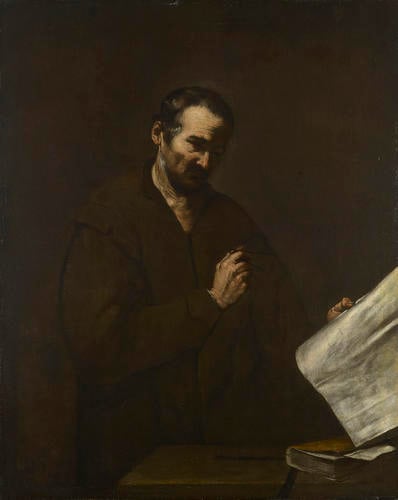-
1 of 253523 objects
The Astrologer c.1630
Oil on canvas | 129.5 x 103.4 x 2.4 cm (support, canvas/panel/stretcher external) | RCIN 405552

Jusepe de Ribera (1591-1652)
The Astrologer c.1630
-
Spanish artist Jusepe de Ribera spent most of his career in Italy and his trenchant realism and strong chiaroscuro show the influence Caravaggio and his followers. This intense and expressive painting appears to show a mathematician or astrologer and may be related to a series of portraits by Ribera depicting the philosophers of antiquity.
Ribera was born in Játiva, near Valencia in 1591. The son of a shoemaker, little is known of his early life and career. Documentary evidence indicates that he spent some time in Valencia before travelling to Italy and may possibly have been apprenticed to the studio of Francisco Ribalta. By 1611 Ribera had established himself in Parma, executing a now lost altar piece for a member of the ducal Farnese family. He is believed to have left Parma for Rome between 1611 and 1613, travelling by way of Bologna where he took inspiration from the work of the Carracci. Ribera remained in Rome for a number of years and is known to have associated with other Caravaggisti working in Rome, including Dutch artists Gerrit van Honthorst (RCIN 405746) and Hendrik ter Bruggen (RCIN 405531).
In 1616 Ribera travelled to Naples, where he would remain for the rest of his life. During the early seventeenth century, Naples was controlled by a succession of Spanish viceroys and Ribera enjoyed the patronage of the small Spanish ruling class and Flemish merchant community, as well as the Italian nobility passing through Naples. Ribera died in Naples in 1652. Although he never returned to Spain, Ribera's works were known through etchings and those paintings taken back by his Spanish patron in Naples and his influence is visible in the work of Velázquez, Murillo and many other Spanish painters of mid-seventeenth century.
Ribera's late Roman phase and early Neapolitan activity are so closely related that it is difficult to accurately date the series of half-length figures of apostles, sages and philosophers that were made during this period and to which this painting may belong. All follow the same compositional format and restricted palette and are characterized by a Caravaggesque use of light to define depth, volume and form and to highlight the immediately expressive faces of his models. Here the man stands behind a table, another common feature of Ribera's half-lengths. The dividers in his right hand and a paper with the signs of the zodiac in his left have led to suggestions that he is a mathematician or astrologer. Ribera's repertoire of wise old men with deeply wrinkled skin and knotted hands was well established by the 1620s and similar figures can be seen in two paintings dated 1615-16 and c.1630, both identified as Greek philosopher Democritus and this painting in the Royal Collection. Another version of this work, dated c.1630 exists the Samuel H. Kress Collection, Arizona.Provenance
Possibly the Spagnoletto of 'Duns Scotus' in the First Room at Leicester House in 1749, in which case acquired by Frederick, Prince of Wales; more certainly in the Drawing Room at Buckingham Palace in 1790; taken to Windsor Castle in 1804/5, it appears there in the King's State Bedchamber in 1813 & 1816; a label on the reverse states that it was taken from Windsor to Hampton Court on 25 April 1832
-
Creator(s)
-
Medium and techniques
Oil on canvas
Measurements
129.5 x 103.4 x 2.4 cm (support, canvas/panel/stretcher external)
147.6 x 121.6 x 6.0 cm (frame, external)
Category
Object type(s)
Alternative title(s)
The Astronomer?
Scholar with a map, previously entitled
A Philosopher, previously entitled
The Mathematician, previously entitled